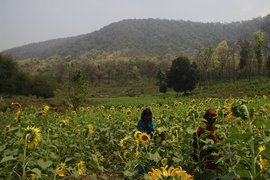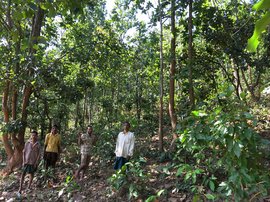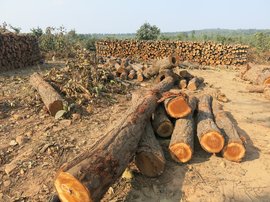Rukhmini Shingte, a lean sugarcane cutter in her mid-40s, bends double to enter the cramped enclosure of sugarcane stalks that has been home to her four-member family since November when they left their village. Like the thousand other homes in this colony of sugarcane cutters outside the Mula Sugar Cooperative in central Maharashtra's Ahmednagar district, her hut too only contains a battered tin case of clothes and a bunch of worn vessels.
Over 500 kilometres away in south Gujarat, outside the Bardoli Cooperative, one of the state's largest and earliest sugar cooperatives, a ragged army of more than a thousand harvesters feeds a continuous supply of cane to the factories, relocating from field to field every few weeks.
The koytas , literally 'sickle' but factory-speak here for 'cutters', are the rural poor from a slew of districts in Maharashtra , from Nandurbar and Nashik to Pune and Jalgaon.
Every year, when the monsoon begins its retreat from the villages of central Maharashtra's arid Marathwada belt, up to half-a-million of its rural poor begin a desperate migration for work that ends in India's largest swathe of sugar country.
The great expanse of sugarcane fields begins in the diamond industry city of Surat in southern Gujarat, sprawls across prosperous western Maharashtra, and tapers into Belgaum in north Karnataka. The harvest season typically runs from November to April, and in particularly good seasons like this year, even longer, until May. The cutters have harvested a record crop of 81 lakh tonnes this year.
The annual migration is over four decades old; its routes are well established. The employers – more than 200 sugar cooperative factories across the three-state swathe – and employees – landless or subsistence farmers – are also constant. But sugarcane profits keep spiralling: an estimated Rs. 15,000 crore this year, according to Prakash Naiknavare, managing director of the Maharashtra State Sugar Cooperative Factories Federation (MSSCFF). The profits grow even as the migrants remain impoverished.
Two-thirds of Maharashtra's sugar factories are in the hands of some of the state's leading and wealthiest politicians, including Chief Minister Vilasrao Deshmukh of the Congress party, and leader of the opposition, the Bharatiya Janata Party's Gopinath Munde. The koytas are mostly from Maharashtra's historically disadvantaged castes and tribes. Little of their sub-marginal land is irrigated, forcing them to abandon their villages at the end of the rain-fed agricultural season. In contrast, their destination is a lush expanse of the water-intensive sugarcane crop, serviced by a large network of dams.
There's a big advantage to having an army of labourers working round-the-clock to feed Maharashtra's 172 factories in these days of record harvests and competitive economic growth. "Unlike other states like Uttar Pradesh, here cutters, not farmers, cut the cane, ensuring it is at the factory and crushed within 24 hours," says Naiknavare. "That ensures Maharashtra has a higher recovery rate of sugar from the sugarcane – 11.5 per cent, as opposed to the national average of 10 per cent."

Living on the edge
Each winter, as the migration begins, large refugee camp-like colonies take shape outside factory gates. The colonies' inhabitants make do without running water or electricity. In such circumstances, women and girls who migrate for work, face additional hardships. They have to collect water from a communal source for the entire family, and they are forced to bathe in the open.
In the darkness of the night, between 2 a.m. and 3 a.m., cutter couples of husband and wife, often accompanied by their older children, leave for the sugarcane fields, returning by the end of the afternoon to join a long line of cane-laden bullock carts at the factory gates, feeding an uninterrupted supply of cane that keeps the factories humming 24/7.
During the day, the settlement's only inhabitants are the aged and little children. Smoke rises from the burning cowdung cakes that young girls, some of them less than 10 years old, cook on. Household work, including cleaning, cooking and taking care of any cattle, gets delegated to the girls. The ICDS (Integrated Child Development Services) does not take into account the needs of rural Indians on the move, and thus ignores the children in these colonies.
Because they migrate, families also lose other welfare entitlements like foodgrain under the public distribution system. Food must be procured from different sources. In Bardoli, over the sickly sweet stench of the molasses, women cook the coarse, low-quality jowar that the factory gives them as part payment. Some migrants' colonies have grain shops, like the one outside the Nevasa factory.
There are no public health services that the migrant workers can access; the factories have a doctor to deal with injuries or fever – more to keep the cutters fit for work than concern for their health. The work is physically draining, and the workers have learned to live with body aches and ailments.
School is a sugar-coated dream
An empty dusty godown is the factory-run sakhar shala (sugar school) in Beed. It is housed in the Vaijnath Sugar Cooperative run by Gopinath Munde. It has no water or toilets, desks or benches. You will also not find any children from the sprawling colony of cane cutters, only a register with over 200 names that shows near universal attendance. When asked about the empty school in his factory, BJP leader and former deputy chief minister Munde said: " Sakhar shalas might not be running, but at least they have been set up. Is that not a great improvement from before?"
In the colony outside, children wander unattended. Sheetal Munde, who should be in the school, is among them, collecting water for the day's use. She was once in school, but the annual migration slowly weaned her out. "I missed school for six months and then failed. Then I left," she says. Sheetal cuts cane and is also assigned the work of cooking, cleaning and taking care of the livestock. Like several children in the colony, she makes bundles of the tops of sugarcane stalks that can be sold (Rs 30 for 100 bundles of 20 stalks each) to the village as fodder to contribute to the family's income.
Multiply Sheetal's story by 1.7 lakhs to see the effects on education of the distress migration. That is the figure thrown up by a survey done through village schoolteachers for the ongoing school year, by the state's Sarva Shiksha Abhiyan (SSA). In Uppalkheda, for example, by November 2006, more than 100 families left for the sugarcane fields of Surat. "The classrooms are emptied of 60-70 per cent of students," says teacher K. S. Rathod.
Government officials claim they are addressing the fallout of this annual six-month migration. "Half the children, or about 70,000, have been kept back in village hostels that we began this year, and have not migrated with their parents," said Narendra Kawde, director of the SSA. "All the others are being covered by sakhar shalas run by the sugar factories."
The education department puts the burden of educating migrant children on the mills, providing them with annual grants. According to SSA Directorate statistics, 643 schools – more than four at every sugar factory – are ensuring that migrating children get education. On the ground, many factories have no schools. In others, like Munde's Vaijanath factory, the schools do not function.
The SSA or 'Education for All', the Centre's six-year-old flagship programme, was aimed at ensuring that all children complete five years of school education by 2007. But it has not managed to ensure this for one of the most vulnerable groups of children, in transit for half the year. Thousands of children continue to fall through the cracks, despite the sakhar shalas at the factory and resident hostels in the village.
A state survey in Latur indicated that only 550 children have been migrating. But at Vilasrao Deshmukh's Manjara cooperative sugar factory in Latur – just one of 10 in the district – a survey by local schoolteacher Purushottam Gilda, in December 2006, showed over 200 children of school-going age living outside the factory. "It is especially hard to ensure that parents send the girls to school," Gilda says, "since they are needed to do the housework when the parents work in the fields."

The work terms are deeply exploitative, violating all existing labour legislation and pinning the workers down in a never-ending cycle of privation
Profiteering from distress
In addition to living in extremely difficult conditions, the work terms are deeply exploitative, violating all existing labour legislation and pinning the workers down in a never-ending cycle of privation.
Factories hire the cutters in couples through an obscure but efficient network of labour brokers or mukadams , who thrive on the seasonal distress. A few thousand rupees, advanced in the monsoon, allow the family to subsist. This amount must be paid back through labour in the harvest season. Whole families, adults and children, then get pulled into the work.
In the darkness of the night, after a day's harvesting in the fields, Rukhmini shows us a heap of crumpled parchis (chits) that record the amount of cane her family has cut over the past few weeks. With no formal education, like most other women cutters she can neither read the figures nor will they bring her family any direct wages. They are guides for the factory to fix the mukadam 's commission, which ranges from 10 to 30 per cent.
Naiknavare, managing director of the MSSCFF since 1999, sees little wrong in the work terms of the migrant cutters, who feed his federation's 172 sugar factories with an uninterrupted supply of cane in the threshing season. He argues: "The 9 lakh cutters do not fit in the proper definition of labour since they are neither my (the factory's) direct employees, nor the mukadam 's. They are therefore not labourers in the formal sense."
Neeraj Hatekar, economist at Mumbai University, explains the lopsidedness: "Migrants from Marathwada have no stake in the cooperative set-up. Factories, headed by politicians, are unwilling to incur any costs on them. So political parties will agitate for a better price for sugarcane but never any basic rights for the cutters... they continue to remain at the very margins."
Dutch anthropologist Jan Breman, who began studying the condition of the cane cutters in 1976 in Surat , says he has seen little change in three decades. "In the new economy of India, labour at large gets a raw deal and migrants even more so," says Breman. "At the bottom of the labour market the supply is much higher than the demand and this explains the weak bargaining position of seasonal migrants such as sugarcane harvesters. It is a feature of a labour regime which is thoroughly informalised."
The state of the sugarcane cutters exemplifies the worst trends of India 's poorly regulated informal sector, which employs over 300 million, or 90% of India 's workforce. Unorganised labourers like cane cutters were high on the agenda of the UPA government, which set up the National Commission for Enterprises in the Unorganised Sector as a watchdog and advisor.
A draft Unorganised Workers Social Security Bill, prepared by the Commission, has been with Prime Minister Manmohan Singh's Office since May 2005. Now, the Commission has put out a draft of yet another proposed legislation, the Unorganised Agricultural Sector Workers (Conditions of Work and Livelihood Promotion) Bill, for feedback from state governments and civil society agencies.
The National Rural Employment Guarantee (NREG) programme was meant to arrest distress migration by giving rural households 100 days of assured work every year after the monsoon. At least half of those on such rural works, the law says, must be women. But in several villages from where cane cutters migrate, the programme does not exist. In Uppalkheda village, full of empty houses, the reason is evident. The sarpanch is a key implementer under the NREG programme. Devidas Pawar, the sarpanch of this village of Vanjarias in northern Aurangabad, doubles up as the mukadam : he, and before him his father, have been sending villagers to Surat 's sugar factories for four decades.
The crop has been good this year, the profits high. The mukadams , the politicians, they are all riding the boom. The exhausted workers have returned to their villages with meagre earnings, to carve out a living from arid bits of land. The stench of the molasses is still strong.
A version of this reportage originally appeared in the Hindustan Times in April 2007.




